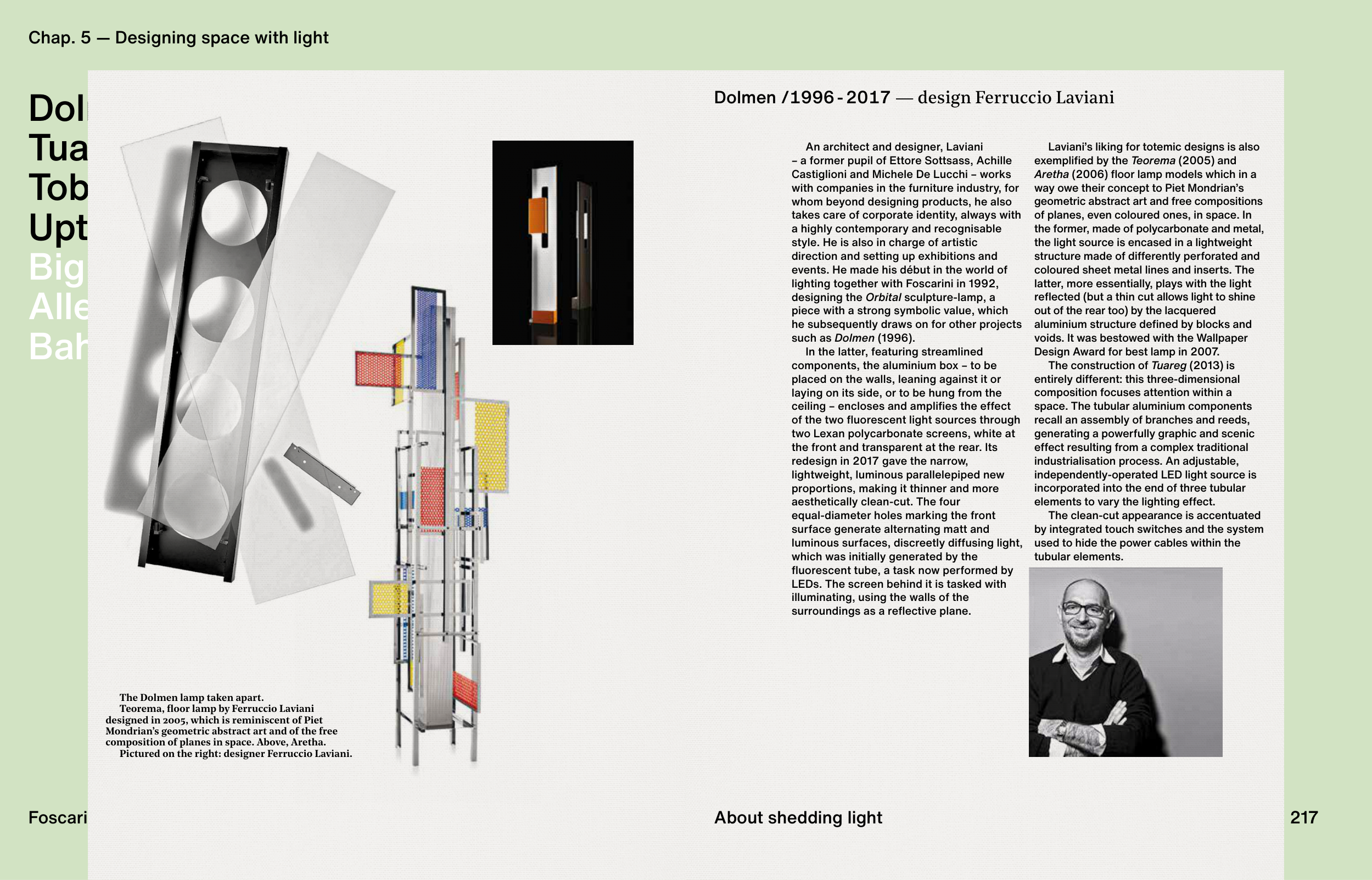217
Dolmen
Tuareg
Tobia
Uptown
Big Bang
Allegro
Bahia
Foscarini
Chap. 5 — Designing space with light
The Dolmen lamp taken apart.
Teorema, fl oor lamp by Ferruccio Laviani
designed in 2005, which is reminiscent of Piet
Mondrian’s geometric abstract art and of the free
composition of planes in space. Above, Aretha.
Pictured on the right: designer Ferruccio Laviani.
Dolmen /1996-2017 — design Ferruccio Laviani
About shedding light
An architect and designer, Laviani
– a former pupil of Ettore Sottsass, Achille
Castiglioni and Michele De Lucchi – works
with companies in the furniture industry, for
whom beyond designing products, he also
takes care of corporate identity, always with
a highly contemporary and recognisable
style. He is also in charge of artistic
direction and setting up exhibitions and
events. He made his début in the world of
lighting together with Foscarini in 1992,
designing the Orbital sculpture-lamp, a
piece with a strong symbolic value, which
he subsequently draws on for other projects
such as Dolmen (1996).
In the latter, featuring streamlined
components, the aluminium box – to be
placed on the walls, leaning against it or
laying on its side, or to be hung from the
ceiling – encloses and amplifi es the effect
of the two fl uorescent light sources through
two Lexan polycarbonate screens, white at
the front and transparent at the rear. Its
redesign in 2017 gave the narrow,
lightweight, luminous parallelepiped new
proportions, making it thinner and more
aesthetically clean-cut. The four
equal-diameter holes marking the front
surface generate alternating matt and
luminous surfaces, discreetly diffusing light,
which was initially generated by the
fl uorescent tube, a task now performed by
LEDs. The screen behind it is tasked with
illuminating, using the walls of the
surroundings as a refl ective plane.
Laviani’s liking for totemic designs is also
exemplifi ed by the Teorema (2005) and
Aretha (2006) fl oor lamp models which in a
way owe their concept to Piet Mondrian’s
geometric abstract art and free compositions
of planes, even coloured ones, in space. In
the former, made of polycarbonate and metal,
the light source is encased in a lightweight
structure made of differently perforated and
coloured sheet metal lines and inserts. The
latter, more essentially, plays with the light
refl ected (but a thin cut allows light to shine
out of the rear too) by the lacquered
aluminium structure defi ned by blocks and
voids. It was bestowed with the Wallpaper
Design Award for best lamp in 2007.
The construction of Tuareg (2013) is
entirely different: this three-dimensional
composition focuses attention within a
space. The tubular aluminium components
recall an assembly of branches and reeds,
generating a powerfully graphic and scenic
effect resulting from a complex traditional
industrialisation process. An adjustable,
independently-operated LED light source is
incorporated into the end of three tubular
elements to vary the lighting effect.
The clean-cut appearance is accentuated
by integrated touch switches and the system
used to hide the power cables within the
tubular elements.
217


